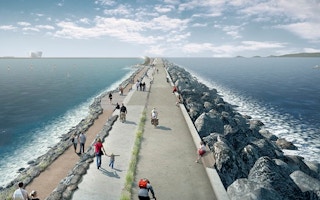Ambitious plans have been drawn up for a network of “tidal lagoons” around the UK coast that could provide up to a quarter of the country’s electricity – and there is potential to roll out the technology in many parts of the world.
Tidal lagoons work by using a wall to capture a body of water in the sea or a tidal estuary pushed in on the rising tide. The water drives turbines as the tide comes in, and then, as the tide falls, the turbines are reversed and the energy from the falling tide is harnessed again.
As Geoffrey Chaucer, one of the earliest English poets put it: “Time and tide wait for no man.” Unlike with wind and solar, the amount of energy being produced from tides is predictable months in advance and is now being recognised as a major renewable resource.
More tidal lagoons
Planning approval has already been given for a £1.3bn pathfinder project at Swansea Bay, south Wales, described by developers as “a scalable blueprint for a new, global, low-carbon power industry”.
Another nine lagoons are planned around tidal hotspots in the Severn estuary and north-west England/north Wales. These would have the potential to generate 25,000MW of electricity – enough to provide 12 per cent of the UK’s electricity needs.
The company behind the proposals, Tidal Lagoon Power, already has teams working in northern France and India, and is studying opportunities in Mexico and Canada’s Atlantic coast. Further tidal lagoon markets may exist in South America, China, south-east Asia and Oceania.
“
We can always rely on tides – they come in and they go out, and they will continue doing so for thousands of years.
Simon Boxall, oceanographer, Southampton University
Tidal power is recognised by the EU’s Joint research Centreas a key contributor to the continent’s future energy mix. Its main attraction is that, unlike other renewable energy sources, it does not require the wind to blow or the sun to shine.
An oceanographer at Southampton University, Dr Simon Boxall, says the technology has improved to the point where tidal energy was a “no-brainer”, with the latest bi-directional turbines capable of generating power on both incoming and outgoing tides.
He says that with sufficient investment it could provide up to a quarter of UK electricity needs within 20 years.
“We can always rely on tides – they come in and they go out, and they will continue doing so for thousands of years. Parts of the UK have tidal ranges in excess of 15 metres, so that’s a heck of a drop of water and that’s happening twice a day – or four times a day when you count the water coming in and going out,” says Dr Boxall.
“The other great advantage is that the tides aren’t the same in different locations, so if you’ve got a network of tidal power stations you are always generating electricity: 24 hours a day, seven days a week.”
In December a former UK Energy Minister, Charles Hendry, published an independent review, concluding: “Power from tidal lagoons could make a strong contribution to UK energy security, as an indigenous and completely predictable form of supply.”
He said the UK was well-placed to take a global lead, and with economies of scale and mass manufacture of turbines, turbine housing and other components costs could be substantially reduced.
Cheap electricity
To be viable the new industry would require subsidies, with a guaranteed premium price for electricity generated. However, Hendry calculates that in the long term tidal lagoons will work out cheaper than wind and “significantly less expensive” than nuclear.
And they could go on generating for 140 years – providing clean, subsidy-free energy long after other energy plants have been decommissioned.
The technology is not without its drawbacks. Artificial lagoons can cause increased silting-up of shipping lanes. Tidal estuaries are also important for wading birds, marine mammals and migratory fish, and conservation groups have warned that the ecological impacts of tidal lagoons are not well understood and that any roll-out of lagoons in the UK should be conditional on the Swansea project being tried and tested.
Backers of the technology say management practices can be adapted to address such concerns – and they point out that lagoons can provide environmental benefits, acting as artificial reefs for marine wildlife.
The UK government is expected to announce a final decision on the Swansea Bay project within the next few months.
This story was published with permission from Climate News Network.










